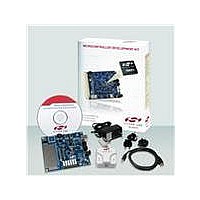C8051F800DK Silicon Laboratories Inc, C8051F800DK Datasheet - Page 11

C8051F800DK
Manufacturer Part Number
C8051F800DK
Description
KIT DEV C8051F800
Manufacturer
Silicon Laboratories Inc
Type
MCUr
Specifications of C8051F800DK
Contents
Board, Cables, CD, Debugger, Power Supply
Processor To Be Evaluated
C8051F800
Data Bus Width
16 bit
Interface Type
USB
Operating Supply Voltage
7 V to 15 V
Lead Free Status / RoHS Status
Contains lead / RoHS non-compliant
For Use With/related Products
C8051F8xx
Lead Free Status / Rohs Status
Supplier Unconfirmed
Other names
336-1797
C8051F800-DK
7.2. Target Board Power Options and Current Measurement (P1, P2, J2, J4)
The C8051F800 Target Board supports three power options:
1. 12 VDC power using the AC to DC power adapter (P1)
2. 5 VDC USB VBUS power from PC via the USB Debug Adapter (J4)
3. 5 VDC USB VBUS power from PC via the CP2103 USB connector (P2, labeled “COMM”)
All the three power sources are ORed together using reverse-biased diodes (D1, D2, D3), eliminating the need for
headers to choose between the sources. The target board will operate as long as any one of the power sources is
present. The ORed power is regulated to a 3.3 V dc voltage using a LDO regulator (U2). The output of the regulator
powers the +3 VD net on the target board, and is also connected to one end of the header J2. A shorting block
should be installed on J2 to power the VDD net, which powers the C8051F800 MCU. With the shorting block
removed, a multimeter can be used across J2 to measure the current consumption of the MCU.
7.3. System Clock Sources (J8, J9)
7.3.1. Internal Oscillators
The C8051F800 device installed on the target board features a factory-calibrated, programmable high-frequency
internal oscillator (24 MHz base frequency, ±2%), which is enabled as the system clock source on reset. After
reset, the internal oscillator operates at a frequency of 3.0625 MHz by default but may be configured by software to
operate at other frequencies. The on-chip crystal is accurate for many serial communications (UART, SPI, SMBus)
and an external oscillator is not required depending on the bit rate. However, if you wish to operate the C8051F800
device at a frequency not available with the internal oscillator, an external crystal may be used. Refer to the
C8051F80x-83x data sheet for more information on configuring the system clock source.
7.3.2. External Oscillator Options
The target board is designed to facilitate the installation of an external crystal. Remove shorting blocks at headers
J8 and J9 and install the crystal at the pads marked Y1. Install a 10 M resistor at R9 and install capacitors at C13
and C14 using values appropriate for the crystal you select. If you wish to operate the external oscillator in
capacitor or RC mode, options to install a capacitor or an RC network are also available on the target board.
Populate C13 for capacitor mode, and populate R7 and C13 for RC mode. Refer to the C8051F80x-83x data sheet
for more information on the use of external oscillators.
Rev. 0.1
11








